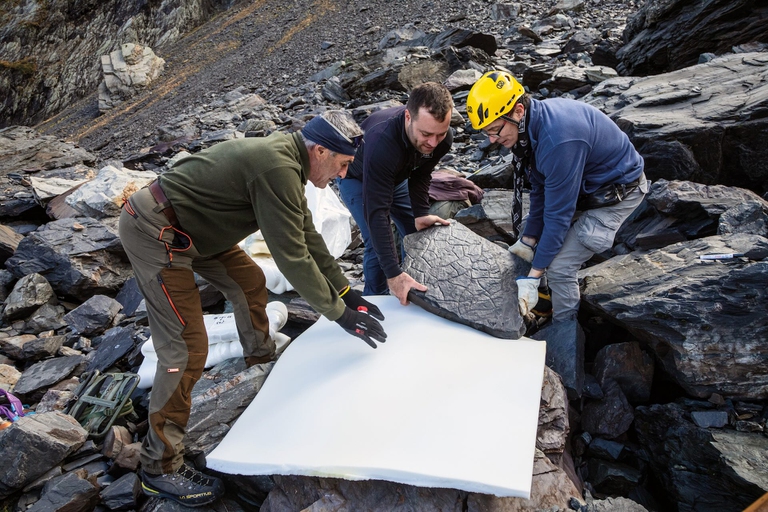https://www.lifegate.it/valtellina-permiano
- |
- An entire ecosystem fossilized on very fine-grained sandstone slabs, which have preserved unimaginable details, remained hidden among the Alpine peaks in Valtellina for 280 million years.
- Now the reduction in snow-glacial coverage due to climate change is bringing it back to light, revealing incredible traces of life and prehistoric nature.
In the heart of the Orobie Park of Valtellina, in the province of Sondrio, an extraordinary discovery has emerged:an entire fossilized ecosystem, brought to light due to the melting of a glacier due to climate changes.The fossils revealed show imprints of very thin fingers, trails of long flexible tails, ripples of waves on the banks of ancient lakes and even drops of rain that fell on the mud, before it became stone set in the walls of the Orobie Valtellinesi Alps and dating back to 280 million years ago, in the period Permian.
The fossils of Valtellina are kept in the museum
The site was discovered by chance by hiker Claudia Steffensen and documented by nature photographer Elio Della Ferrera.It was subsequently the subject of an in-depth study by a team of experts, including the paleontologist Cristiano Dal Sasso of the Natural History Museum of Milan, the geologist Ausonio Ronchi of the University of Pavia and the ichnologist Lorenzo Marchetti of the History Museum nature of Berlin.In one spectacular recovery operation, the first finds were transported downstream with the help of a helicopter and were presented to the public at the Natural History Museum of Milan.
The experts they identified the footprints of at least five species of animals.The fossilized “tracks” – sequences of footprints left by animals walking on the still muddy sediments – offer a unique window into an ecosystem from a time when dinosaurs did not yet exist.The dimensions of the footprints indicate animals with a length between 2 and 3 meters.“The quality of preservation is such that it shows even the details of the fingertips and the skin of the belly”, underlines Marchetti, highlighting the importance of the site for the study of biodiversity of the Paleozoic era.In addition to animal traces, in Val d'Ambria there are - although rarer - plant fossils (fronds, fragments of stems and seeds).Equally interesting sedimentary structures are soil desiccation fractures, wave or current ripples and raindrop imprints, which are providing researchers with many elements for a detailed paleoenvironmental and paleoclimatic reconstruction.
The geological conditions in which these sediments were formed explain the extraordinary preservation of the traces.“The footprints were preserved thanks to the seasonal cyclicality that led to the summer drying of the muddy surfaces, followed by new layers of protective clay,” explains the geologist Ronchi.

The past offers us a valuable lesson
Some might ask what is the use of all this.The team of researchers is unanimous in their answer:“These discoveries are not only of scientific interest.Due to the extension and complexity of the stratifications, this new site represents an important addition to the deposits of fossil footprints from the same era and which have made the Italian southern Alpine sector a place of global significance.But these fossils also tell of a very distant geological period which, like today, was marked by global warming, with the greenhouse effect fueled by massive volcanic eruptions, the melting of the polar ice caps and the expansion of increasingly arid seasonal tropical environments .This favored reptiles over amphibians and led to the extinction of many species.The past offers us a valuable lesson on what we risk causing on our planet today."
In fact, the discovery in Valtellina, in addition to enriching the knowledge of life in the Permian period, represents a curious paradox:It is precisely the melting of glaciers, caused by accelerated climate change in the modern era, that today gives paleontologists the opportunity to study these incredible finds.As geological eras meet in a strange twist of fate, it is as if the past is revealed to warn us not to end up like the dinosaurs.





